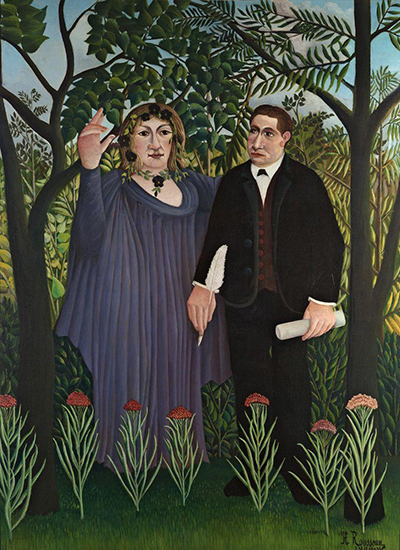Henri Rousseau got inspired to do this painting of his friend Guillaume Apollinaire and his mistress Marie Laurencin out of his love for portrait-landscape. Henri gave the artwork the name "The Muse Inspiring the Poet". Its original French title was "La Muse Inspirant Le Poete."
Rousseau was famous for his naïve (primitivism) art style, which he has clearly depicted in The Muse Inspiring the Poet artwork. The art style was mainly characterised by a lack of proportionality in his drawings and the use of unnatural colours that inspired mystery in all his paintings. His style was better described as having a child-like simplicity.
The artwork was created in 1909 and it originally measured 97 by 146 centimetres. Henry used oil on canvas to clearly bring out the naïve art style in the painting.
A Deeper Insight of The Muse Inspiring the Poet Painting
Rousseau's main theme while doing this painting was keeping up with the landscape-portrait. He used the flowers in the foreground as a symbol of the poet's immortal soul. Marie Laurencin, on the other hand, acts as the Muse and the inspirer where she's like a Greek peplos. In Apollinaire's hand, he's holding a quill, which is a perfect symbol of his professionalism as a poet, ready to write down his thoughts. The painting was done after the great Picasso reception in honour of the Douanier-Rousseau's nickname, who worked at the Paris customs office for 15 years.
History of the Painting
The Muse Inspiring the Poet portrait is the second version of the original one where Marie Laurencin requested Turkish carnations at their feet, symbolising poets. However, when Rousseau visited a botanical garden for inspiration and to create sketches, he got confused. He ended up drawing gillyflowers on the ground, in front of the poet and Muse’s feet. The flowers he added symbolised death and neglect. His move was not politely received by Marie.
In the artwork, Marie's portrait was also unlike her. She, typically, had a wasp waist and was slender but in the portrait, Rousseau portrayed her as quite the opposite. When Rousseau was asked why he did that, his reply was, "But a great poet needs a great muse". When Marie saw the painting, sources claim she laughed wildly and never took the painting home. The artwork remained at Rousseau's home until it got the attention of Sergei Shchukin, a Russian philanthropist and art collector who bought it to be part of his collections.
The Muse Inspiring the Poet - Second Version
However, later, Apollinaire felt the urge to possess the painting. He went looking for it at Rousseau’s with the intention to take it home. This made Rousseau make the second version of the painting where he fixed the flowers and Marie's look, especially the waist. Apollinaire's image in Basel also looked neater. The decorations and landscape also improved while the look of Marie's neck averaged. Marie's neck is a symbol of decoration, and the trees signify the arch representing the objects. Interestingly, Rousseau believed he was an academic painter, something that made him achieve much more. Other items from his career to look out for include Surprise, Dream and Snake Charmer.




